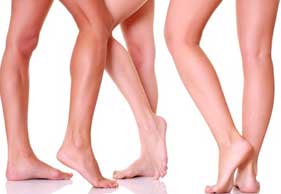Many endurance athletes know the painful sensation of
shin splints: A localised, sharp pain on the front of the shin bone, which can
either strike in the middle of a training run, making you limp back home and
spend the rest of your evening with an ice pack applied to your leg, or can
stay with you long after the run and reduce your walk to a painful shuffle. The
first step in dealing with this condition is a reduction in distance and intensity,
or complete rest, because if you do not reduce the stress on the connective tissue surrounding the
tibia (shin bone), a stress fracture may eventually occur!
TOO MUCH TO HANDLE
Shin splints, or medial tibial stress syndrome (MTSS), can be caused by a number of factors, says Johannesburg-based
physiotherapist Toni Hesp, a multiple Comrades and Ironman finisher. These include taking on longer distances too
quickly, using shoes that do not offer enough cushioning, or overloading your
training programme with intense days without allowing enough rest or ‘easy’
days in between.
“Anterior shin splints is a condition that presents
with pain on the inside of the shin bone and there is often exquisite
tenderness if pressure is applied along the edge of the shin bone,” she says. “Increased
strain on the bone causes an increase in the bone remodelling process that
occurs naturally and strengthens the bone. However, demineralization of bone
occurs in the first three months of training, while fitness improves after 10
weeks, so runners often increase their intensity just when the bone is at its
weakest.” At this point, increased stress on a weakened bone over a period of
time can ultimately cause a point of weakness that eventually cracks, resulting
in a stress fracture. It is therefore important to allow the bone to adapt to
the stress by following a conservative build-up, with regular rest days, so
that the bone can get stronger without being overstressed.
PRONATION PLAYS ITS PART
Increasing your intensity and duration of training can
also put a lot of stress on tendons that aren’t used to absorbing the impact of
the shock of landing so soon. For example, you wouldn’t take on a 10km if you
haven’t done any training whatsoever. Similarly, you may love running hills so
much that you want to tackle hill sessions four times a week, but that’s
putting added strain on those muscles. Excessive pronation and taking on
high-impact, irregular terrain can also be a factor.
“Consider the biomechanics of your feet and ensure
that you are wearing the correct running shoes – and if necessary ask a
podiatrist,” says Toni. “High levels of ankle pronation could cause localised
traction on the bone, or the twisting force as the foot rolls inwards could
lead to increased bone stress. Inadequate core muscle strength can also add to
stress on the skeleton and exacerbate the pronation, and core strengthening may
be required.” Toni also suggests that runners can try reducing their stride
length, as a greater stride results in the foot striking the ground with
greater force. The muscles in the front of the leg then have to work harder to
prevent the foot from slapping the ground, and eventually this results in pain
from the increased strain.
The bottom line is that you need to assess your
training carefully for any changes in mileage, speed, surfaces or shoes prior
to the onset of the injury. And then it’s all about recovery, with a week or
two to rest, assessing one’s programme to cut intensity or distance, all while
stretching the tibialis anterior (the muscle two-thirds up the shin bone). The following
tips should also help you to overcome your shin splints pain:
?
Don’t run through the pain. It might come and go, but
it’ll be no help if you keep training like you do. Stress fractures might occur
and you’ll be out longer than you think.
?
TLC for shins: Massaging and icing your shins can reduce the
inflammation.
?
Check your shoes! Shoes with worn insoles are a no-no, so try
out a pair with supportive
material on the inside heel-edge of the sole.
?
Mix it up: If your shins are burning on the run, rather focus on
creating some fitness off the road. Swimming or cycling doesn’t tax your shins
as much as going for a run every day.
?
Build it up: If you have a goal distance in mind, then work up to
that distance slowly and efficiently.


